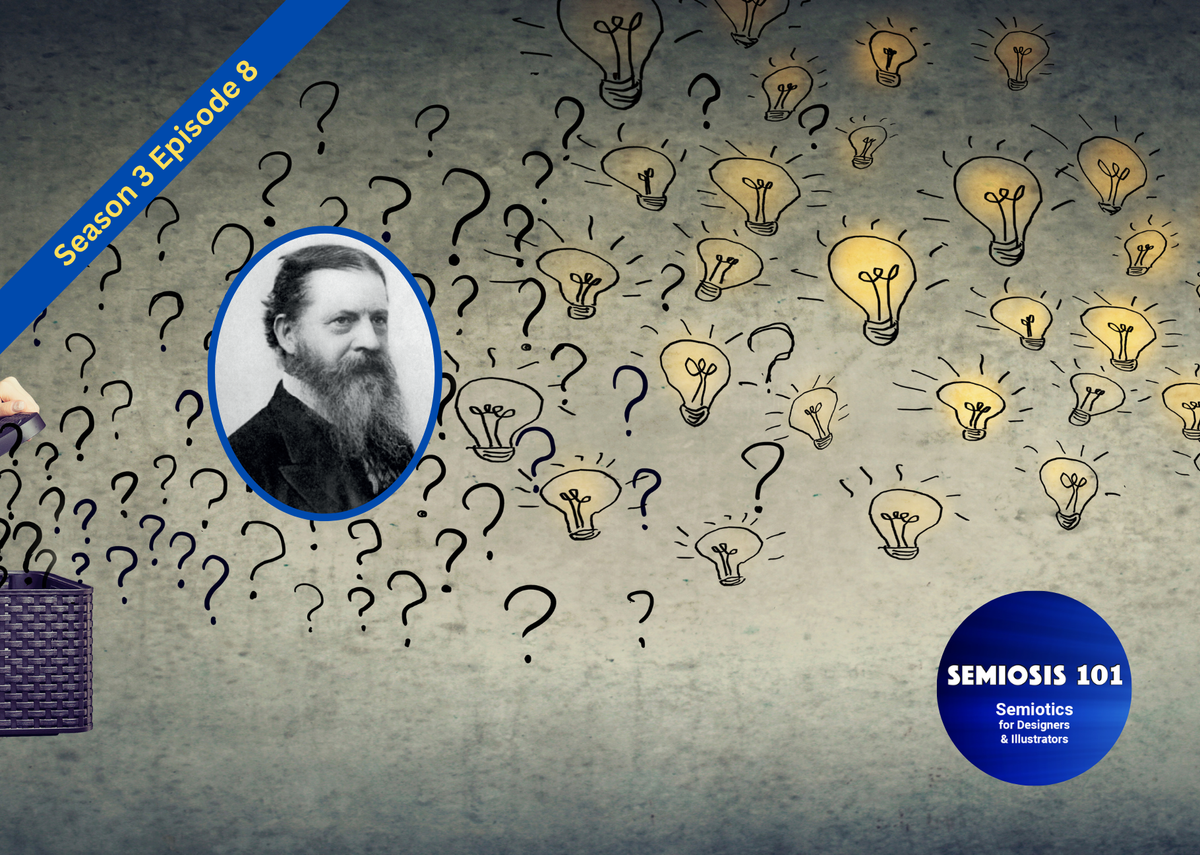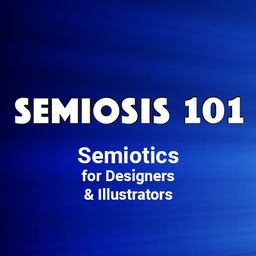Free Semiosis 101 Transcript 3.8:

ANSWERING THE BRIEF: Making Idea Generation Semiotic
Hello readers.
In this free transcript for the episode published on Semiosis 101 on 20 December 2023, we will now go deeper into semiotics at the ideation stage. All creatives working commercially have a target audience. This may be defined by the client or it may mean some research on the creative’s part. In semiotic encoding the audience is key!
Watch the free episode on YouTube for the full impact…
…and here is the episode’s transcript.
Way back in season one episodes I used several episodes to prepare the ground for where we are in the next three episodes on semiotic ideation. In season two I constantly referred to the ideation phase and how Abductive reasoning - the Logic of Design - can help you creatives to formulate Hypotheses on who your target audiences are.
Let us now go deeper into semiotics at the ideation stage. Hit subscribe to this YouTube channel, and I will explain…
Ideation. Ideation. Ideation.
I use this term a lot, but you may call this first phase at the beginning of any creative work something else. Let us agree we are talking about the same thing. The creation of possible ideas that may solve the creative problem set by the client.
Whether this is a design problem of brand X or an illustration problem of create a set of 10 illustrations for this book. It all begins with possibilities rather than definitive final outcomes.
Those possibilities come from research-led insights that kickstart the creative process. But let us consider if those possibilities can be enhanced. All creatives working commercially have a target audience. This may be defined by the client or it may mean some research on the creative’s part.
In semiotic encoding the audience is key!
In season two we spent a lot of episodes we focused on creative’s engaging a lot of time in Abduction. No, not kidnapping, Abductive reasoning - the Logic of Design. This is about forming a logical Hypothesis of who your target audience are. This reasoning based on research reveals insights on the target audience’s lived experiences. In turn, this provides creatives clues to what familiar qualities and resemblances to known things the audience will perceive, which creatives can then semiotically hack.
Peirce says, “Nothing is a [semiotic] sign until it is first interpreted as a sign.” Without knowing what a panda is, an audience would never arrive at an interpretation of a drawing of panda as a panda! What comes first the semiotic sign or the image? Let us not think in binary terms.
If three people look at a pattern of black splodges and perceive three different interpretations, the black splodges remain what they are. Perception of the visual element may see the marks either as just random marks, or they are meaning-bearing. Human’s are hard-wired to interpret visual elements for signs of meaning. In our distant hunter-gatherer past it was the daily survival balance between eating something or being eaten by some thing!
As creatives, every mark you make has the potential by the target audience to be interpreted as meaning-bearing, whether you encode meaning into a splodge or not. So Semiosis offers you the semiotic framework to actively visually encode meaning where you intend it.
Okay? Back to our three people looking at black splodges. What could these black splodges mean, if anything?
To one person they just see black splodges and nothing else. They do not perceive anything. To this person, they are not meaning-bearing.
To the second person, they perceive the same black splodges form a pattern that suggest to them something. In their lived experience they are familiar with the shape of an animal. The black splodges offer them the possibility that the pattern they form is not random. The alignment resembles in their perception, the qualities of legs, a body and a head, etc.. This person interprets the same black splodges AS meaning-bearing.
The final person perceives exactly the same as the second person, but in their lived experience they can go much further in their interpretation than the second person. They go from a possibility to name the thing they see as a panda.
These are the same black splodges, but perceived in three different ways, with two different interpretations, with only one person “seeing” the panda. It is the panda we wanted them to interpret. Let us flip this example from perception to semiotic encoding of the visual elements.
In the drawing of the panda, the creative has used certain marks to form the shape of what we know as a panda. The distinctive black and white markings are crafted in such a way, utilising the Gestalt of Figure/Ground to emphasise a panda.
Semiotically speaking, each mark used is individually meaning-bearing. Each mark is an encoded semiotic sign. Think of each mark as a micro visual communication building block, which is semiotically functioning at the lowest level of Iconic representation (yes I know MARK also has a meaning in branding).
What do we do when we sketch? We make rough drawings and tentative drafts of what we may eventually take to completion. These drawings, in whatever media, can represent features of observed scenes or objects, or conjure up things from memory or imagination. Often sketches are preliminary studies of intention, used to problem solve composition, point of view, or other forms of problem-solving. Sketching can be observational or purely propositional. Sketching is still, in its rough state of aesthetic finish, visual communication.
“Sketches, however, typically use quick marks and simple lines to capture only the essential elements of the subject matter. A sketch will usually lack many of the details that a finished drawing would have. The fundamental elements will get worked out in a sketch, such as the composition, proportion, scale, and the balance between values.” Eden Gallery
https://www.eden-gallery.com/news/drawing-vs-sketching
Ideation involves sketching. Ideation in a creative process, whether by a graphic designer or illustrator, follows three stages. These are idea generation, idea selection, and idea development.
The client in their brief provides you with a creative visual communication problem to solve. Research provides you with insights from contextual knowledge gleaned from a variety of sources. Ideation is the process you have all been doing since day one of design school, whether you call it that or not. You generate ideas by sketching these possibilities. You visually communicate possible creative solutions to others (and yourself) with the minimum of visual marks.
How does someone else see your possible solution from a few roughly sketched marks?
They interpret what they see from their lived experiences. But how clear have you been in sketching the idea?
If the person (a fellow creative, a client?) does not successfully interpret what you hope they will, then as the creative you can then simply adjust the sketch to visually communicate your intended meaning with more clarity. At each stage of ideation you adjust your sketches toward the development of a successful visual communication solution to the brief.
At each stage of ideation, from generation, selection and development of ideas you are crafting the visual language from your sketches to become meaning-bearing. At each stage of ideation you move from possibilities, to propositions, to finally, visual communication of the intended meaning through your aesthetic decisions.
Whether you realise it or not, you have always been semiotically encoding levels of meaning into your chosen visual language. Peirce’s Semiosis now helps you to finesse how well you do this.
With Semiosis 101 I am lifting the veil of semiotic theory to show the alignments to what creatives already do. In translating arcane semiotic terminology into your existing creative process, Semiosis 101 brings Peircean semioticians and creatives closer into a mutually-beneficial communicational situation. Let me summarise how ideation is essentially semiotic.
Brief > Research > Idea Generation > Idea Selection > Idea Development > Outcome
That is a creative process. It is not linear. As each step in itself is fluid. Next week we will explore this semiotic topic with the design double-diamond. The brief sets the communicational problem to solve. Research provides the creative with contextual knowledge to provide understanding and insights into both the brief’s topic AND the target audience. These insights provide initial ideas.
The creative then can begin sketching possible visual ways to convey these ideas to the audience. As soon as the sketching attempts to convey ideas, the creative is semiotically encoding initial ways to convey meaning. But at this sketching stage all they have to do this are lines, marks, shapes, colours, etc. These basic visual communication building blocks of potential meaning will remain lines, marks, shapes, colours, etc. until someone ELSE interprets what they see as possibilities of familiar qualities and visual resemblances to things THEY know.
But surely they are just lines, marks, shapes, colours, etc.? As soon as the individual elements are interpreted as meaning something more (Gestalt), the basic building block begins to work semiotically. Just imagine if, as a creative, you could be more effective in doing this. Come back next week when we will go deeper into the ideation process to apply Semiosis.
Semiosis 101 Semiotic Design Resources is a reader-supported publication. To receive exclusive posts and support my work, consider becoming a free or paid subscriber. Paid subscribers get name checked on all future Semiosis 101 YouTube episodes.
===Semiosis 101 Patreon Producer==============
Become a Semiosis 101 Patreon Producer and get a named producer credit on future video episodes, plus watch all new episodes months ahead of YouTube.
===Semiosis 101 Patreon Exclusives==============
Watch longer Patreon-exclusive Semiosis 101 episodes on applying Semiosis into design and illustration…
PATEXC001 How does semiotics work in illustration?





